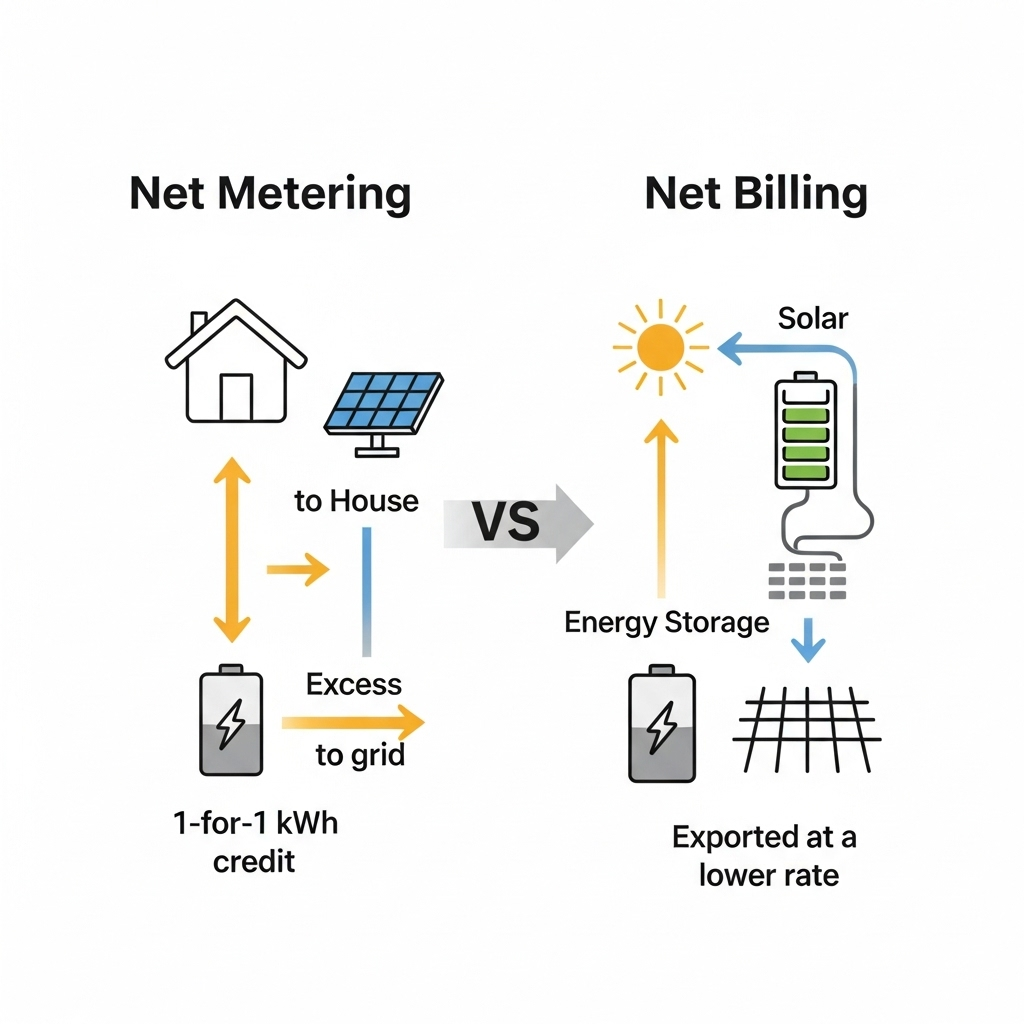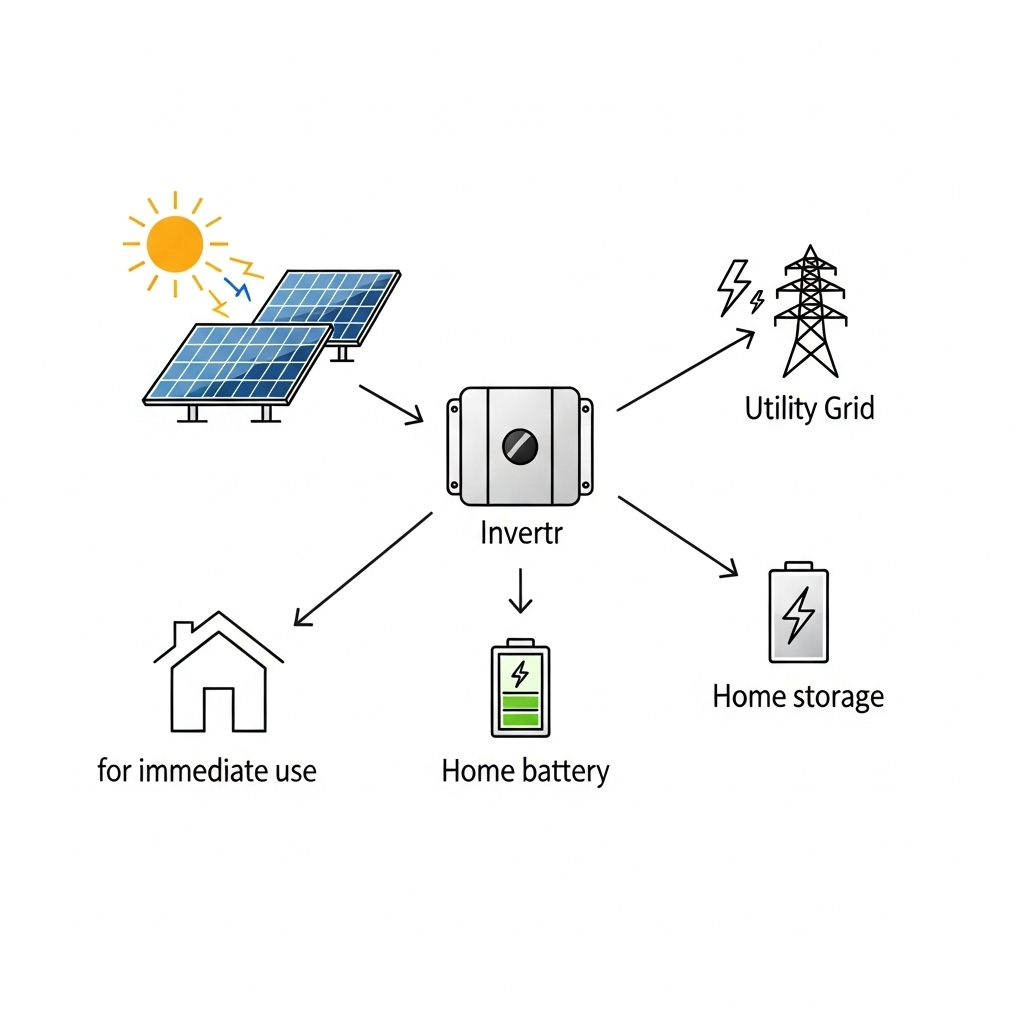Once you decide to install a rooftop photovoltaic (PV) system, you face a critical financial decision: how will you be compensated for the electricity you generate? The tariff structure you choose directly impacts your savings and the return on your investment. The three primary models are net metering, gross metering, and feed-in tariffs (FiTs). Each has distinct mechanics and financial implications. Understanding them is the key to making an informed choice that aligns with your energy goals and local regulations.
Understanding Net Metering: Using the Grid as Your Battery
Net metering is one of the most common compensation models for rooftop solar. It is a billing mechanism that credits solar energy system owners for the electricity they add to the grid.
How Net Metering Works
With a net metering arrangement, the electricity your solar panels produce first powers your home. If you generate more electricity than you consume at any moment, the surplus energy flows out to the utility grid. Your electric meter runs backward to record this export. You receive credits for this exported energy, which you can use to offset the cost of electricity you draw from the grid at other times, such as at night or on cloudy days. In many traditional net metering programs, these credits are valued at the full retail electricity rate, creating a 1-for-1 exchange.
Who Benefits Most from Net Metering?
Net metering is particularly advantageous for homeowners whose energy consumption aligns with solar production hours—typically during the middle of the day. The more solar energy you consume directly (a practice known as self-consumption), the more you save, as you avoid purchasing expensive retail electricity. However, policies are evolving. Many regions are shifting from traditional net metering to 'net billing' or 'Value of Solar' tariffs. Under these new structures, exported energy is often credited at a rate lower than the retail price. According to the U.S. Department of Energy, these policies aim to more accurately reflect the value that distributed solar provides to the grid. This shift makes maximizing self-consumption even more critical.
Decoding Gross Metering: The 'Buy-All, Sell-All' Approach
Gross metering operates on a completely different principle than net metering. It treats your rooftop PV system as a small, independent power plant dedicated to selling electricity to the utility.
The Mechanics of Gross Metering
Under a gross metering, or 'buy-all, sell-all,' model, 100% of the electricity generated by your solar panels is immediately exported and sold to the grid at a predetermined rate. Simultaneously, you buy 100% of the electricity your home needs from the grid at the standard retail rate. This requires a meter that can track both imported and exported electricity separately. As a report by the International Energy Agency (IEA) highlights, this structure effectively separates the act of generating power from the act of consuming it.
When is Gross Metering a Good Option?
Gross metering can be financially attractive if the rate paid for your exported solar power is high and guaranteed, potentially even higher than the retail rate you pay for consumption. This model is often beneficial for properties with very low daytime energy usage, such as a home that is empty during the day or a commercial property that operates mainly at night. The success of this model hinges entirely on the 'sell' price offered by the utility. If the export tariff is low, this model is rarely favorable compared to net metering, where self-consumption provides savings at the full retail rate.
Feed-in Tariffs (FiTs): A Guaranteed Price for Your Power
Feed-in Tariffs are a policy tool designed to accelerate investment in renewable energy technologies. They offer a straightforward and often lucrative incentive for generating clean power.
What are Feed-in Tariffs?
A Feed-in Tariff (FiT) is a payment mechanism where the utility pays a fixed, and often premium, price for each kilowatt-hour (kWh) of renewable electricity a producer exports to the grid. These rates are typically set for a long-term period, such as 10 to 20 years, providing financial certainty for the system owner. According to the International Renewable Energy Agency (IRENA), FiTs have been successfully used worldwide to encourage the adoption of technologies like solar PV. An FiT can exist as a standalone program or be combined with a net metering structure, where you are paid the FiT rate only for your net excess generation.
FiTs vs. Metering Schemes: Key Differences
The primary distinction is that FiTs guarantee a specific *price* for your electricity, while metering schemes focus on *crediting* your account. FiTs are a direct payment for generation, making the financial return predictable. Net metering, on the other hand, provides savings through bill reduction, and the value of those savings can fluctuate if retail electricity rates change. The long-term contracts associated with FiTs offer a level of investment security that is attractive to many homeowners and businesses.
Making the Right Choice: A Comparative Analysis
Choosing the right compensation model depends on your consumption patterns, local policies, and financial goals. A direct comparison can help clarify which path is best for you.
Comparing Financial Returns
The financial outcome of each model varies significantly. Below is a table summarizing the key aspects of each tariff structure.
| Feature | Net Metering | Gross Metering | Feed-in Tariff (FiT) |
|---|---|---|---|
| Compensation Method | Bill credits for surplus energy, often at retail rate. | Sell all generated power to the grid; buy all consumed power from the grid. | Fixed payment per kWh exported to the grid. |
| Primary Benefit | Maximizes savings through self-consumption. | Provides revenue as a power generator. | Guaranteed, predictable income stream. |
| Best For | High daytime energy users who can self-consume. | Low daytime energy users where export rates are high. | Anyone seeking long-term financial certainty. |
| Financial Certainty | Moderate; depends on future retail electricity rates. | Variable; depends on the 'sell' vs. 'buy' rate spread. | High; rates are often fixed in a long-term contract. |
The Role of Battery Storage
Adding a home battery storage system fundamentally changes the financial equation for any tariff structure. Instead of exporting surplus solar energy to the grid for a potentially low credit—especially under net billing or unfavorable FiT schemes—you can store it for use later. This strategy maximizes self-consumption, ensuring you get the full value from every kWh your panels produce by avoiding grid purchases. To effectively size a battery, you need a clear picture of your system's capabilities. You can get an in-depth look at the key metrics in this ultimate reference on solar storage performance, which helps you match battery capacity to your energy goals and achieve greater energy independence.
Local Regulations Matter Most
Ultimately, your choice is limited by what is available in your area. Solar compensation policies are determined by state, provincial, or national governments and local utilities. As seen in markets like India, rules can vary dramatically between states, with some offering net metering for small systems and mandating gross metering for larger ones. Before making a final decision, you must research the specific programs offered by your utility. A qualified local solar installer is an invaluable resource for navigating these regulations and modeling the financial performance of each available option.
A Final Look at Your Solar Compensation Options
Selecting the right compensation structure is as important as choosing the right solar panels. Net metering rewards you for using the power you generate. Gross metering turns your roof into a small power station. Feed-in Tariffs offer predictable, long-term revenue. As policies evolve away from simple 1-for-1 credits, the value of self-consumption increases. This makes integrating a battery storage system a powerful strategy to secure your energy savings and take control of your power, no matter which tariff you choose.
Frequently Asked Questions
What is the main difference between net and gross metering?
The main difference is how your solar generation is treated. With net metering, you use the solar power you generate first and only export the surplus to the grid. With gross metering, you export all of your solar power to the grid and buy all the power your home needs from the grid in two separate transactions.
Can I have a battery with any of these tariff structures?
Yes. A battery storage system can be beneficial with any model. It allows you to store excess solar energy instead of exporting it. This maximizes self-consumption, which is especially valuable under net billing (where export rates are low) or gross metering (where retail electricity is expensive).
Are Feed-in Tariffs still common?
Feed-in Tariffs were very popular for jump-starting solar markets. While some regions have phased them out in favor of other models like net billing, they are still used in many parts of the world, often for specific types or sizes of renewable energy projects. Their availability is entirely dependent on local policy.
How do I find out which options are available in my area?
The best way is to contact your local electric utility directly. Their website or customer service department will have information on programs for solar customers. Additionally, professional solar installation companies are experts in local regulations and can provide detailed advice on the most financially advantageous options for you.
Disclaimer: This article is for informational purposes only and does not constitute financial or legal advice. Consult with a qualified professional and your local utility before making any investment decisions.





Leave a comment
All comments are moderated before being published.
This site is protected by hCaptcha and the hCaptcha Privacy Policy and Terms of Service apply.